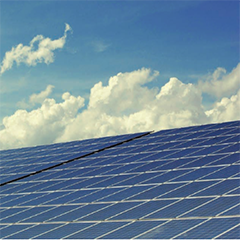PID: a problem in the global solar industry
The performance degradation of solar modules
Renewable energies are among the most important sources of electricity in Germany. Their expansion is a central pillar of the energy transition. Solar energy is one of the most significant renewable energy sources. Photovoltaic systems and solar parks represent an ever-increasing share of global energy production, because photovoltaics offer many advantages: extremely low operating costs and reliable yield forecasts; they do not require extensive construction measures and do not produce either pollutants or noise.
Photovoltaic systems are also becoming particularly attractive in terms of their service life, which is now specified at 20 to 40 years. This depends primarily on the quality of the individual components. The quality of the solar modules, inverter and mounting frame is therefore crucial. The service life of the PV system is also determined by factors such as professional planning and design, the execution of the installation, and regular maintenance and servicing.
A problem that now occurs in many PV systems and considerably impairs their service life is Potential Induced Degradation (PID) – the performance degradation of solar modules. As a result of negative voltage between the solar modules and the ground potential, there is a successive reduction in performance, meaning photovoltaic systems lose efficiency and yield on a daily basis. According to representative measurements and scientific studies, even the newest high-quality solar modules lose at least 0.25% of their Wp output per year.
Since the losses accumulate over the years, the initial, apparently very small 0.25% turns into a loss of at least 5% after a period of 20 years. This means an average annual loss of revenue of 2.5% over the 20-year period. If you view this 2.5% loss in relation to an average return from a PV system of 6-7%, the negative influence of PID on the yields and returns of PV systems can be clearly seen. With environmental conditions such as high ambient temperatures, solar irradiance, air humidity and salt content, more significant degradation is to be expected, resulting in considerable losses in yield within a very short time.
PID: a problem in the global solar industry
The performance degradation of solar modules
Renewable energies are among the most important sources of electricity in Germany. Their expansion is a central pillar of the energy transition. Solar energy is one of the most significant renewable energy sources. Photovoltaic systems and solar parks represent an ever-increasing share of global energy production, because photovoltaics offer many advantages: extremely low operating costs and reliable yield forecasts; they do not require extensive construction measures and do not produce either pollutants or noise.
Photovoltaic systems are also becoming particularly attractive in terms of their service life, which is now specified at 20 to 40 years. This depends primarily on the quality of the individual components. The quality of the solar modules, inverter and mounting frame is therefore crucial. The service life of the PV system is also determined by factors such as professional planning and design, the execution of the installation, and regular maintenance and servicing.
A problem that now occurs in many PV systems and considerably impairs their service life is Potential Induced Degradation (PID) – the performance degradation of solar modules. As a result of negative voltage between the solar modules and the ground potential, there is a successive reduction in performance, meaning photovoltaic systems lose efficiency and yield on a daily basis. According to representative measurements and scientific studies, even the newest high-quality solar modules lose at least 0.25% of their Wp output per year.
Since the losses accumulate over the years, the initial, apparently very small 0.25% turns into a loss of at least 5% after a period of 20 years. This means an average annual loss of revenue of 2.5% over the 20-year period. If you view this 2.5% loss in relation to an average return from a PV system of 6-7%, the negative influence of PID on the yields and returns of PV systems can be clearly seen. With environmental conditions such as high ambient temperatures, solar irradiance, air humidity and salt content, more significant degradation is to be expected, resulting in considerable losses in yield within a very short time.
To read the full content,
please download the PDF below.


























